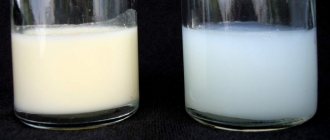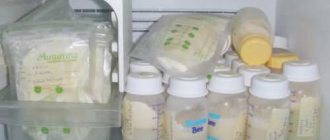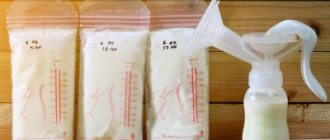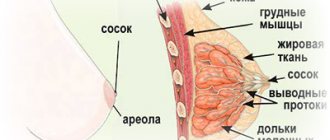What does breast milk look like?
Some mothers, due to their inexperience, after the birth of their first child are interested in what color breast milk is. When answering the question of what breast milk looks like and why breast milk is yellow, it can be noted that its color often changes throughout the entire period of breastfeeding. This is due to various factors: the nutrition of a nursing woman during breastfeeding, hormonal balance, and the state of the central nervous system.
Breast milk contains a large amount of vitamins and minerals. After the baby is born, breast milk is most often yellow in color, in some cases it is orange. This is due to the production of colostrum during the first days. after childbirth, it is best suited for feeding a newborn; it consists of a special easily digestible protein and a natural analogue of beta-carotene, which is responsible for increasing the body’s protective qualities. Also, breast milk may turn yellowish due to its low fluid content.
After half a month, as a rule, the color of breast milk normalizes and acquires a whitish tint, which is due to the stabilization of the level of proteins, carbohydrates and fats in the product. At the same time, the production of breast milk increases two to three times, the volume of fluid increases, as a result of which the baby’s food becomes liquefied and loses its yellowness. As the baby grows, the product in the mother's breast becomes pale bluish. Deviations in this color scheme are possible.
What color should breast milk be?
The female body produces a fluid with a unique composition. The production of infant formula has made a big breakthrough over the past decades. Now you can buy food of different compositions, for children with gastrointestinal problems and children with allergies. However, it has not yet been possible to create an ideal alternative to breast milk.
During lactation, the volume, density and color of milk changes.
The shade is affected by:
- lactation period;
- child's appetite;
- woman's nutrition;
- taking medications;
- Times of Day;
- emotional condition;
- hormonal background;
- diseases and pathologies.
Breast milk is traditionally white, but the hue can be blue or yellow, pinkish or brown. Sometimes greenish milk is produced. If you pay attention to the properties of biological fluid, you can notice changes from one stage of lactation to another.
Colostrum
After giving birth, mothers notice that their breast milk is clear. The fluid that is released during the postpartum period is called colostrum. For some women, it leaks even before giving birth. The translucent substance is the ideal first food for a baby. Colostrum has a yellowish-transparent tint. Despite the lack of rich white color, it is beneficial for the child.
Colostrum contains a lot of protein. This diet contains virtually no water or fat. This is good because a newborn's kidneys are not yet able to cope with a large volume of fluid. In the first days, 10-30 ml of colostrum per feeding is enough for the baby.
Sometimes mothers, seeing drops of transparent yellow thick liquid on the nipples, worry about the lack of milk. However, nature provided for this moment. Not a single newborn baby who received colostrum on demand has ever gone hungry.
Transitional
It's okay if the milk becomes clear a few days after birth. The stages of lactation development differ from girl to girl. Therefore, mothers, comparing the color of milk with their roommates, find differences.
Transitional milk replaces colostrum 2-4 days after birth. Instead of a thick yellow substance, a white-transparent liquid is released from the chest. Transitional milk is thinner. It flows out of the breasts more easily, and its volume increases every hour. This diet contains less protein, and the levels of fat, carbohydrates and water increase. Transitional milk lasts for 1-2 weeks.
Mature
Breastfeeding mothers often say that their milk is blue. Many women, due to existing stereotypes, consider him “empty.” The girls use different tricks to make the food yellow. There is a myth that this color indicates high nutritional value.
In fact, a bluish tint to baby food is a sign of mature lactation. This period begins approximately 2 weeks after birth. The volume, composition and color of food are stabilized. Women see that with each feeding a white liquid is released, which sometimes takes on a specific shade.
During mature lactation, the color, volume and composition of milk depends on the needs of the baby and on the lifestyle of the nursing woman.
Front and rear
During each feeding, the baby receives two types of milk, which differ in composition and color.
- In the first 5-15 minutes of sucking, the baby receives foremilk. It is quite liquid and flows out of the breast easily. If you collect it in a container, you can see that the woman has clear, white milk. This diet contains large amounts of water and carbohydrates. It quenches thirst well and replenishes energy reserves.
- Hind milk is yellow or deep white. It is thicker than the front one. It is more difficult to obtain, so the baby makes an effort and actively sucks. This diet contains a lot of protein and fat.
Sometimes women notice that a greenish liquid is released from their breasts. This often occurs after eating plant-based green foods. This does not affect the composition of baby food. If a nursing mother eats a lot of pumpkin, carrots or other orange vegetables, her milk will have a yellowish tint.
Involutional
By the time breastfeeding is completed, involution occurs. Mom notices that liquid of a different consistency and shade is released from her breasts. Baby food is no longer rich white. It is thicker and produced in smaller quantities.
Involution milk is clear or yellowish. It visually resembles the one that stood out immediately after childbirth. During involution, it is also affected by the foods and medications that the mother consumes.
If a nursing mother is pregnant
Hormonal levels are important for a nursing mother. During times of stress, baby food production decreases as adrenaline and cortisol are present. During menstruation, mothers also notice changes. If a nursing woman becomes pregnant, this will inevitably affect lactation.
During pregnancy, a special hormonal background is established in a woman’s body. If previously the main goal was breastfeeding, now a new goal appears - to maintain the pregnancy. Baby food changes composition, volume and shade.
Many women notice that with the onset of a new pregnancy, the volume of food for the baby has decreased, and it has become yellowish-transparent. Visually, baby food becomes similar to colostrum - the liquid that was produced immediately after birth.
Sometimes babies refuse breastfeeding when their mother becomes pregnant again, because even the taste of food changes. Doctors also recommend curtailing lactation when a woman comes to them about a new pregnancy. However, many mothers manage to maintain breastfeeding and organize tandem feeding.
Colostrum and transition milk
The color of colostrum and transition milk is influenced by the following factors:
- Physical and psycho-emotional state of a nursing mother.
- Inclusion of prohibited foods during lactation, for example, smoked, too salty, spicy foods.
- Consumption of alcoholic beverages.
- Smoking.
We recommend reading: How to understand that your baby is not getting enough breast milk
Colostrum has a thick consistency and is formed in the mammary glands during gestation. A few days after the baby is born, transitional milk replaces it. The norm is a yellowish-cream color of colostrum, which is due to its composition, which is dominated by fats. This product may taste salty or sweet. Transitional breast milk, in turn, should be white or slightly yellowish, with a runny consistency. To evaluate the structure and color of the contents of a woman's breasts, you need to use a breast pump.
Mature milk
The transitional milk stage ends around the second week of the baby's life. Next, mature milk is gradually formed, which will not change dramatically throughout breastfeeding. The only changes are a slow decrease in protein and an increase in carbohydrates.
Once in the baby’s body, breast milk coagulates into tiny flakes. Cow's or goat's milk is unacceptable for feeding newborns, as it is too heavy a product for the baby's gastrointestinal tract.
Due to the fact that women's milk has body temperature, it enters the baby's body almost sterile. The composition contains bactericidal substances that are extremely necessary for the baby in the first months of life. A priori, the components of human breast milk cannot be antigens for the child.
GV is also necessary for the normal development of the emotional component. During breastfeeding, physical contact occurs, allowing the baby to feel completely safe in a “new” world for him.
Hind and foremilk
Foremilk consists of milk sugar, vitamins and water. Thus, the product saturates the child’s body with valuable compounds, carbohydrates, and replenishes the lack of fluid. Foremilk has a liquid consistency and is whitish in color (almost transparent).
After a quarter or a third of an hour of intense suction, the baby can receive a portion of hindmilk. The structure of such baby food has a high density. The posterior fluid is whitish in color and is considered the most nutritious part of the breast contents. It consists of fats and proteins.
Some babies refuse to take hind milk and begin to be capricious, since it is much more difficult to absorb this nutritious liquid. Many nursing mothers immediately substitute the other breast, filled with foremilk containing milk sugar (lactose) . This provokes stool disorders and colic, because the children's digestive system is not endowed with so many enzymes for the normal digestion and assimilation of this component. In this case, the child may not be well-fed enough, which causes restless sleep, moodiness, and deviations from the norm in weight. To eliminate this phenomenon, a nursing mother should put her baby to the breast frequently.
Yellow milk
Sometimes breastfeeding women may wonder why breast milk is yellow. There is always a moment for women when a young mother puts her child to her breast. It is worth immediately noting that in no case should you worry about this type of color of the product, because the yellow color does not indicate its deterioration or illness of the mother. It is completely acceptable to feed a newborn baby with this product.
If a woman expresses milk at different times, you will notice a special pattern that it will also be of a different color. Its color will change, and, in addition, its composition. Fat content does not always have to be the same. It can change its properties every day or between pumping processes throughout the day. Having expressed milk at the beginning of feeding, the woman will receive a bluish color of the product. And if you express milk at the end of feeding, it will turn out to be fattier. Accordingly, the color will turn yellow.
Milk color at the involution stage
Answering the question of what color breast milk should be during involution, it can be noted that thick yellow discharge, similar to colostrum, is considered normal. This happens when the baby is constantly breastfed for one and a half years after the birth of the baby. Such a product has the goal of forming and strengthening the baby’s immunity for further consumption of various foods.
A nursing mother should take into account that a change in color may occur due to the use of certain medications or dishes containing food coloring.
Blood impurities
Streaks of blood are often observed with a rapid flow of milk. The cause of this condition is minor hemorrhages. Other causes of blood in breast milk include:
- Wearing tight underwear, which leads to prolonged compression of the mammary gland.
- The appearance of abrasions and cracks in the nipple area.
- The occurrence of bleeding caused by the proliferation of malignant and benign tumors of the mammary glands.
Before continuing to feed the baby such food, the young mother should consult a specialist to find out the causes of bleeding. In some cases, a woman may need a course of medication or surgery. Next, we’ll talk about purulent discharge and blood impurities in milk in more detail.
Not all women have an idea of what color breast milk is. The photo will help you figure this out.
Factors affecting the color and composition of milk
A variety of factors can cause the color change. This often happens due to the consumption of certain dishes, for example, pumpkin, carrots, potatoes. This can be explained by the ban on red vegetables and fruits under the Guards. Many women try to compensate for the lack of certain valuable substances by consuming yellow vegetables. Because of this, breast milk can take on a yellowish tint. When eating greens, green vegetables and drinks in unlimited quantities, the baby's food may become greenish.
We recommend reading: How to increase breast milk lactation
During natural feeding, pediatricians do not recommend drinking carbonated drinks. If this restriction is regularly violated, the color of the milk may also change from whitish to pinkish or orange. This phenomenon occurs due to the dye content. In addition, the color of milk can be affected by medications or the presence of chronic diseases in nursing mothers.
The listed violations are not critical; they can be easily eliminated by eliminating one or another provoking factor.
Can an adult drink breast milk?
You can, but breast milk is a fluid produced by the body, so you might not want to drink breast milk from someone you don't know. Breast milk has been tried by a large number of adults (you mean I didn't put cow's milk in my coffee?) No problem. Some bodybuilders have used breast milk as a sort of "superfood", but there is no evidence that it improves performance in the gym. According to a scientific journal, there are several cases where people suffering from cancer, digestive disorders and immune disorders have used milk from a breast milk bank to combat their diseases. But again, research is needed.
What changes in milk should you be wary of?
When certain diseases occur in breast milk (after expressing), various pathological impurities can be detected. In this case, a nursing woman should consult a mammologist. The doctor will help determine the exact cause of the pathology and prescribe appropriate therapy.
Blood
Greenish milk mixed with blood may appear due to intense hot flashes, and it is impossible to exclude the possibility of mild hemorrhages. Among the reasons for the appearance of blood in milk are the following:
- Wearing tight underwear, which interferes with normal fluid circulation in the mammary glands.
- The presence of cracks, abrasions, damage to the nipples.
- Formation of tumors of various types.
If the pathology in question occurs, breastfeeding is allowed only after a visit to a doctor, who must conduct an examination, refer the woman for tests and rule out the development of serious consequences. In some cases, medication or surgery can help correct discoloration of breast milk.
Milk color is normal
Bluish, white or yellow milk color is normal; the presence of these shades is often caused by changes in milk composition at different stages of lactation. Colostrum usually has a yellow or orange tint. As for the color of mature breast milk (pictured), it is normally pale and slightly blue. And at the natural end of lactation, milk turns yellow, after which it soon stops being produced altogether. Now let's move on to consider the reasons why milk changes color.
Why is breast milk blue?
You can often hear a woman say that her milk is blue, so she is afraid to feed it to her child or is afraid that the child will not get enough. This fear is shared by grandmothers, who advise feeding the baby “normal” cow’s milk or porridge. Mothers do as they want: either they listen to their elders, as a result of which they very quickly stop breastfeeding altogether, or they begin to look for an answer on the Internet and ask breastfeeding specialists - in such mothers, the child breastfeeds for up to a year or longer. What is better for a child and what is “blue milk”?
The value of human milk
Comparing a woman with a cow is considered a sign of bad taste - it is offensive and indecent, but replacing women's milk with cow's milk is quite acceptable... There is some inconsistency in this. Cow's milk is intended to feed calves, and woman's milk is intended to feed human children - this is an axiom! It has been proven that the milk of a particular species of mammal contains all the necessary nutrients and components in order to fully implement the development program of this particular species of mammal. Man is no exception.
Human milk is responsible for the fine differentiation of brain neurons, which ensures the formation of a particular worldview at a high level. It is not for nothing that Chinese emperors were fed human milk until they were six years old.
Vitamins, microelements and immune defense factors, which are found in large quantities in human milk, are invaluable for the child, directly affecting his immunity. A bias towards mixed and artificial feeding of previous generations, breastfeeding during the first day, and not immediately after birth - aren’t these the reasons for the huge number of allergic diseases that have swept the whole world, which are not found in wild civilizations, whose women simply feed this way? as programmed by nature.
Composition of human milk
When a person says the word “milk,” then, of course, he imagines a glass of cow’s milk - this is the standard of perception. What does cow's milk look like? Every woman knows that good milk has a rich white, yellowish color, and “blue” milk is lower in quality, it is low-fat. But it is rare that a modern woman milks a cow and knows that milk from the cow’s udder also flows unevenly - the thickest milk is released at the end of milking. With a woman it’s the same, only the milk is different - human, specially created by nature to feed a human child.
Immediately after the baby is born, milk from the mother’s breast is released in small quantities and has a yellow color; in essence, it is not milk, but colostrum - a concentrate of all useful and nutrients for the child, who cannot yet eat much, but gets everything necessary components for your growth and development.
Several days pass (individually for each mother) and the colostrum gradually turns into the usual white milk. The child grows, and the composition of human milk changes, corresponding to each period of the child’s growth.
When the mother has enough milk, pressing on the breast before feeding the baby, you can find that the milk released is almost transparent, with a bluish tint. This discovery frightens mothers, although in reality there is nothing scary. It’s just that first a more liquid portion of milk with a large amount of galactose is released, which the child can quickly suck out and quench his thirst and first hunger, and only then thicker milk with an increased amount of fat begins to flow. You can easily check this fact by expressing milk before and after feeding. The first drops will be transparent bluish, and the last ones will be white-yellowish. Both portions of milk are equally important for a child's development.
Source: profilaktica.ru
What to do if the milk has changed color?
First of all, don't panic. Anxiety can harm lactation, and the baby also feels the mother’s tension. Secondly, it is necessary to find out the reason for the color change.
- If the day before a woman ate beets, carbonated drinks and other foods containing dyes, there is no need to worry. The pigment will not harm the baby and will soon be removed from the milk. However, it is still advisable to follow a diet for nursing mothers so as not to provoke an allergic reaction in the child.
- If a mother eats a lot of greens, trying to enrich her body with vitamins, the diet should be reconsidered. The fact is that excessive intake of such food can cause an eating disorder in a child.
- Do not forget about the physiological color of milk. The color does not have to be strictly white. It is assumed that it takes on a bluish, yellowish tint.
- If other symptoms appear simultaneously with the changed color of the milk (high fever, severe chest pain, the color becomes bright red), you should immediately seek help from a doctor. The specialist will conduct an examination, prescribe additional research methods and make a diagnosis, on the basis of which he will draw up a treatment regimen.
Important! With such manifestations, you cannot self-medicate! Otherwise, such self-medication can lead to dangerous complications.
Breast milk can change its composition, color and taste during different lactation periods, completely adapting to the needs of the baby. It is not surprising that as a result of such changes it takes on a different shade. A young mother is concerned about any discoloration of the milk. Her worries are not always justified. Most often, the reason lies in physiological factors. If a woman is very concerned about the color of her milk, it is advisable to consult a doctor. The specialist will accurately answer whether this is normal or pathological.
Source: topotushky.ru
Is it normal for milk to be pink or greenish?
Such sharp fluctuations in the color palette of human milk are not always symptoms of pathology in the mammary glands or any diseases in the nursing mother herself. Everything could be simpler and more prosaic.
The green color in breast milk is most often discovered by nursing mothers who allow themselves to eat greens and vegetables in large quantities. Immediately after childbirth, the female body is acutely lacking in sufficient amounts of vitamins, and they try to solve this problem on their own.
Such a violation rarely affects the baby’s health, since only a small number of plants in our gardens can provoke an allergic reaction in him. It’s a completely different matter if the unnatural color of nipple discharge is associated with the mother’s consumption of carbonated drinks with artificial colors.
Not only are such dietary errors prohibited for nursing women, since their contents can cause various pathological reactions in an ordinary healthy person. Artificial dyes can cause a malfunction in the baby’s immune system and make his body susceptible to various infections and bacteria.
The pink color of the milk most often signals that as a result of feeding, cracks have formed on the nipples, and blood is getting into the milk. Usually, in such cases, mothers are not advised to stop breastfeeding, since the presence of droplets of blood cannot cause much harm to the baby.
Sometimes bloody stains appear in breast milk even with completely intact nipples. Most often, the cause of this phenomenon can be the presence in a woman of various benign processes in the mammary glands, which manifest themselves precisely during lactation.
Pink color requires a lady to make an emergency trip to the doctor. Most often, this shade is caused by a violation of feeding techniques, and an experienced specialist will help the young mother with advice and suggest special ointments. If such a pink color is the result of benign formations in the mammary glands, then a visit to the doctor is simply necessary.
We recommend reading the article about colostrum and breast milk. From it you will learn about the differences, composition, nutritional properties and benefits for the child.
And here is more information about the fat content of breast milk.
Only a specialist will be able to determine whether a change in the color of breast milk is a reason to stop breastfeeding. It will also help to identify the factors that provoked changes, and will also tell you whether it is necessary to be examined or whether there is no reason for alarm.
Stages of changing appearance and composition
The color of breast milk changes from yellow to bluish-white during the first weeks of breastfeeding.
The composition of a mother's breast milk changes at different stages of the baby's development. So, in the first days after birth, it contains more protein than in subsequent periods, but less fat and lactose. Mature milk is higher in calories, and the content of vitamins and minerals in it is lower than in primary milk. It has been scientifically proven that the composition of breast milk changes, regardless of the mother's diet, frequency of meals or calorie intake. The content of proteins, fats, carbohydrates, and nutrients can change even during one feeding. The most significant factor influencing the composition of milk is the baby's age.
Table: changes in composition during different periods of lactation
| Component | Colostrum(days 1–5) | Transitional milk (6–14 days) | Mature milk (from day 15) |
| Protein, g | 2,3 | 1,6 | 1,1 |
| Fat, g | 2,6 | 3,5 | 4,5 |
| Lactose, g | 5,7 | 6,4 | 6,8 |
| Energy value, kcal | 67 | 73 | 75 |
| Vitamin A, mg | 0,16 | 0,09 | 0,06 |
| Carotenoids, mg | 0,14 | 0,04 | 0,02 |
| Vitamin E, mg | 1,5 | 0,9 | 0,2 |
| Sodium, mg | 50 | 30 | 17 |
| Potassium, mg | 74 | 64 | 50 |
| Calcium, mg | 48 | 46 | 34 |
| Zinc, mg | 1,2 | 3,8 | 5,6 |
Colostrum
Colostrum is yellow in color, it is thicker than mature milk, and is released in a small volume.
Immediately after birth, the mother’s mammary glands begin to secrete a yellowish translucent liquid, which is called colostrum. This is primary milk, the volume of which is very small. Sometimes it begins to leak from the breast even before the baby is born. In some cases, colostrum has an orange tint, which is due to the presence of a high concentration of beta-carotene, a precursor to vitamin A, in the composition.
In the first days of life, only 30 g of colostrum per feeding is enough to meet the baby's nutritional needs. This is due to the small volume of the baby’s stomach. At the same time, the nutritional value of colostrum is high due to the low water content in the composition. The baby receives all the necessary nutrients without overloading the newborn’s kidneys. Let us list the main unique properties of primary milk:
- High protein concentration. This is necessary for the active growth and development of cells and tissues of a small person. Colostrum protein is different from the protein contained in mature milk; it is easier to digest and does not require a large amount of gastric juice for its digestion.
- Saturation with immune factors. A whole complex of valuable nutrients received in the first days after birth with colostrum forms passive immunity until the baby reaches 2 months of age. In fact, colostrum is a powerful immune stimulant and adaptogen.
- Content of immunoglobulin A. Colostrum contains different immunoglobulins, but this particular variety is of particular importance. Secretory immunoglobulin A provides protection to the mucous membranes, including those in the intestines, protecting the body from the penetration of pathogenic microorganisms.
- Mild laxative effect. By receiving colostrum, the body quickly clears birth stool - meconium. This helps prevent the development of newborn jaundice, which occurs due to the presence of bilirubin in meconium.
By receiving colostrum, a newborn baby gains protection from negative factors and infections in a new environment.
Transition milk
Transition milk may be yellowish, but is lighter in color than colostrum.
About 3 to 5 days after birth, colostrum replaces transition milk. Its name corresponds to its appearance - milk is more liquid than colostrum, gradually its color changes from yellow to white. Transitional milk is saturated with water, and the protein concentration is lower than in the first days after birth, which is due to the natural needs of the child. The mother may notice that the baby is attached to the breast more often and needs more milk for each feeding. The mother's body adapts to these changes, increasing lactation. These days, lactation begins to develop, so it is recommended to put the baby to the breast on demand and often hug the baby to increase the production of prolactin, the lactation hormone.
The transitional stage lasts until the child is about two weeks old, and the composition of milk has the following features:
- High content of carbohydrates and fats. There is no need to strengthen the muscle frame at this stage, so the proportion of protein in milk decreases, but the body needs strength to adapt to new living conditions and complete the formation of internal organs and systems.
- Increased dose of lactose. An increase in lactose content has a positive effect on the taste of milk, making it sweet and appetizing to the baby. This nutrient provides the baby with energy for motor activity and is converted into substances necessary for the development of the brain and the entire nervous system as a whole. Lactose is also required for the formation of normal intestinal microflora of the baby and its colonization with beneficial bacteria.
- HAMLET complex. Human alpha-lactalbumin is used in anticancer drugs that inhibit the activity of tumor cells. It is contained in high concentrations in transitional milk and helps the child’s body suppress cancer cells if they become active during the prenatal period. Breastfeeding can be considered a means to prevent cancer at an early age.
Mature milk
Mature breast milk is usually white, with a yellow or blue tint.
2 weeks after birth, the transitional stage is completed and the milk is called mature. Its composition and volume stabilize, but are adjusted throughout the entire lactation period. This happens spontaneously, depending on the needs of the child. For example, it has been scientifically proven that during the period of illness the baby in breast milk increases the level of substances that help the baby cope with viruses. The color of the milk becomes more saturated and white than before, but sometimes it can change and take on a colored tint due to various factors.
The composition of mature milk is determined by the most significant components:
- Water. Breast milk replaces both water and food for the baby, and the older the baby gets, the more fluid his body requires. Breast milk with a natural type of feeding has an optimal temperature for best absorption and has a gentle effect on the kidneys without overloading them.
- Carbohydrates and lactose. Lactose levels continue to increase as your baby gets older. The child needs more and more energy to master new motor skills, intellectual and physical development. Some children have lactose intolerance, which today is not perceived as an irrefutable argument for abandoning breastfeeding. The problem is corrected by a set of measures that have a positive effect on the baby’s digestion.
- Fats. The proportion of the component in breast milk is increasing. Fats are required for brain function, skin regeneration, and weight gain regulation. The fat content in breast milk is partly influenced by the quality of nutrition of the nursing mother. When consuming foods rich in unsaturated fats (fish, meat, vegetable oil, etc.), the nutritional value of milk increases. With excessive consumption of foods containing saturated fats (fried foods, confectionery, etc.), the milk may become thicker and the baby may experience digestive problems.
- Squirrels. The protein content of mature milk is approximately the same throughout the entire lactation period and does not depend on the mother’s diet. Proteins are “building materials” and are necessary for the baby for growth and development, strengthening the immune system, and quality digestion. The protein composition of breast milk is unique, is absorbed by the child’s body in the best way, and no manufacturer of infant formula can replicate it. This is why the period of newborn colic in breast-fed babies is shorter than in formula-fed babies.
The composition of breast milk is extremely diverse and balanced, it contains vitamins, minerals, fatty acids, and enzymes in optimal proportions.
Involution milk
When the baby is old enough and the mother wants to complete breastfeeding, breast milk becomes similar in appearance to colostrum. The
“mature milk” stage continues throughout the entire lactation period. If a woman decides to stop breastfeeding or this happens naturally, when the number of feedings gradually “disappears”, the phenomenon of involution occurs. This is the physiological process of completing lactation, when milk changes its external and quality characteristics and soon ceases to be produced completely. The color of the milk takes on a pale yellow hue, it becomes thicker and its volume is minimal.
The situation may turn out differently in the event of a sudden cessation of lactation, unexpectedly for the body. Then milk continues to be actively secreted, and in the absence of pumping or putting the baby to the breast, stagnation (lactostasis) can occur, and then mastitis. These inflammatory processes lead to the formation of pus and have an extremely negative impact on the woman’s well-being. The body temperature may rise, areas of compaction may appear in the chest, in some cases the problem can only be solved surgically.
If a nursing mother is pregnant
Pregnancy of a nursing mother can cause changes in the color, taste and consistency of breast milk.
When pregnancy occurs during lactation, the amount of milk may decrease, and its appearance may become closer to colostrum. This is due to hormonal changes in the body of a pregnant woman, which strives primarily to “respect the interests” of the fetus. The taste of milk may also change, which is why many children refuse to breastfeed. Fortunately, even if a new pregnancy occurs immediately after birth, for an older child, mother's milk is no longer an indispensable source of nutrition. In some cases, the mother manages to continue breastfeeding for both babies, but the composition of the milk corresponds to the needs of the younger family member.
I was lucky enough to breastfeed my two babies until they reached the age of 1 year. With my first child, it was not possible to establish breastfeeding from the first days. Our grandmothers are partly to blame for this, in whose heads, back in Soviet times, the prejudice was firmly ingrained that if a newborn cries often, it is because of hunger. I also heard a lot about the “blueness” of my milk and its inability to satisfy the hunger of the “poor child”. Being completely inexperienced in matters of breastfeeding, I listened to the advice of mothers, tried to pump with discipline and lamented that there was very little milk, it was not fatty or white enough. My daughter had already begun to get used to the bottle with the mixture, until a friend with a child of the same age as mine made her contribution. “Why are you even giving this mixture?” — she said dismissively one day during a walk. “What, she can only breastfeed, and why can’t I?” - flashed through my enlightened head. After this incident, my daughter completely switched to breastfeeding, and I noticed that my breasts began to fill more intensely than before. As a result, my daughter drank breast milk until she was 1 year old. Then I decided to lose weight dramatically and somehow my milk supply immediately decreased significantly, but that’s another story... I approached the birth of my second child, 5 years later, with all responsibility and preparation. But, even knowing that lactation would improve gradually (I was never an obvious “milk nurse”) the thought of a life-saving formula still flashed through my head when my son demanded the breast every half hour, or at most an hour. Fortunately, my patience was enough until the situation more or less stabilized, the intestinal colic subsided, and the baby began to behave calmer. However, we fed very often, especially in the first six months. The weight indicators were normal. Communicating with like-minded women while walking with children, I realized that I was lucky - my children were “edible”, actively suckled at the breast, and my daughter did not neglect the “boobs” even when at the same time she received formula from a bottle. However, not everyone has it so simple. So, one friend pumped with a machine throughout the entire breastfeeding period, since the child refused to suckle from the breast. Another friend took expressed milk to the laboratory for analysis - she was embarrassed by the blue tint and transparency of the breast fluid, and the restless behavior of the baby. As a result, pathogenic microflora was found in the milk and it was recommended that she stop breastfeeding. The third interlocutor's milk turned out to be too fatty, and the child suffered from lactase deficiency. But she had the wisdom to maintain breastfeeding, and the digestive problem was resolved over time, including with the help of various medications. Based on my experience, I concluded that you should not focus on the color or consistency of breast milk - nature itself will put everything in its place. Of course, you should be wary if there are serious “symptoms”, something wrong - the appearance of pus or blood, but in my experience with mothers, this happens very rarely.











